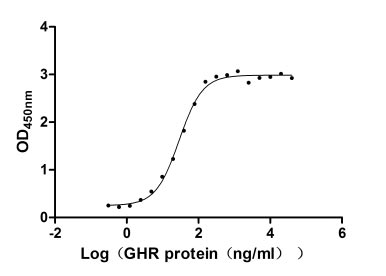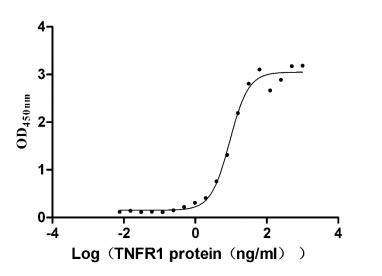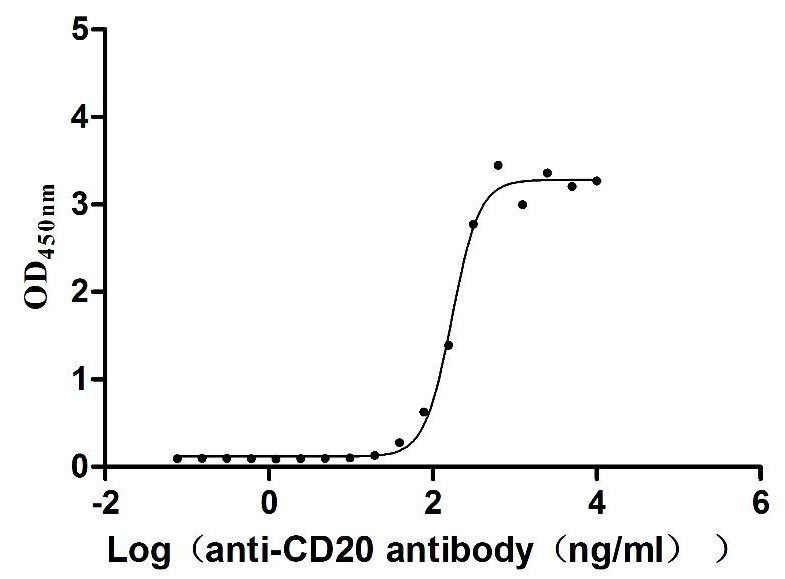Recombinant Human SH3 domain-binding protein 2 (SH3BP2)
-
货号:CSB-YP021224HU
-
规格:
-
来源:Yeast
-
其他:
-
货号:CSB-EP021224HU
-
规格:
-
来源:E.coli
-
其他:
-
货号:CSB-EP021224HU-B
-
规格:
-
来源:E.coli
-
共轭:Avi-tag Biotinylated
E. coli biotin ligase (BirA) is highly specific in covalently attaching biotin to the 15 amino acid AviTag peptide. This recombinant protein was biotinylated in vivo by AviTag-BirA technology, which method is BriA catalyzes amide linkage between the biotin and the specific lysine of the AviTag.
-
其他:
-
货号:CSB-BP021224HU
-
规格:
-
来源:Baculovirus
-
其他:
-
货号:CSB-MP021224HU
-
规格:
-
来源:Mammalian cell
-
其他:
产品详情
-
纯度:>85% (SDS-PAGE)
-
基因名:
-
Uniprot No.:
-
别名:3BP-2; 3BP2; 3BP2_HUMAN; Abl SH3 binding protein 2 ; Cherubism ; CRBM; CRPM; FLJ42079; FLJ54978; RES4-23; SH3 domain binding protein 2; SH3 domain-binding protein 2; Sh3bp2; TNFAIP3 interacting protein 2
-
种属:Homo sapiens (Human)
-
蛋白长度:Full length protein
-
表达区域:1-561
-
氨基酸序列MAAEEMHWPV PMKAIGAQNL LTMPGGVAKA GYLHKKGGTQ LQLLKWPLRF VIIHKRCVYY FKSSTSASPQ GAFSLSGYNR VMRAAEETTS NNVFPFKIIH ISKKHRTWFF SASSEEERKS WMALLRREIG HFHEKKDLPL DTSDSSSDTD SFYGAVERPV DISLSPYPTD NEDYEHDDED DSYLEPDSPE PGRLEDALMH PPAYPPPPVP TPRKPAFSDM PRAHSFTSKG PGPLLPPPPP KHGLPDVGLA AEDSKRDPLC PRRAEPCPRV PATPRRMSDP PLSTMPTAPG LRKPPCFRES ASPSPEPWTP GHGACSTSSA AIMATATSRN CDKLKSFHLS PRGPPTSEPP PVPANKPKFL KIAEEDPPRE AAMPGLFVPP VAPRPPALKL PVPEAMARPA VLPRPEKPQL PHLQRSPPDG QSFRSFSFEK PRQPSQADTG GDDSDEDYEK VPLPNSVFVN TTESCEVERL FKATSPRGEP QDGLYCIRNS STKSGKVLVV WDETSNKVRN YRIFEKDSKF YLEGEVLFVS VGSMVEHYHT HVLPSHQSLL LRHPYGYTGP R
-
蛋白标签:Tag type will be determined during the manufacturing process.
The tag type will be determined during production process. If you have specified tag type, please tell us and we will develop the specified tag preferentially. -
产品提供形式:Lyophilized powder
Note: We will preferentially ship the format that we have in stock, however, if you have any special requirement for the format, please remark your requirement when placing the order, we will prepare according to your demand. -
复溶:We recommend that this vial be briefly centrifuged prior to opening to bring the contents to the bottom. Please reconstitute protein in deionized sterile water to a concentration of 0.1-1.0 mg/mL.We recommend to add 5-50% of glycerol (final concentration) and aliquot for long-term storage at -20℃/-80℃. Our default final concentration of glycerol is 50%. Customers could use it as reference.
-
储存条件:Store at -20°C/-80°C upon receipt, aliquoting is necessary for mutiple use. Avoid repeated freeze-thaw cycles.
-
保质期:The shelf life is related to many factors, storage state, buffer ingredients, storage temperature and the stability of the protein itself.
Generally, the shelf life of liquid form is 6 months at -20°C/-80°C. The shelf life of lyophilized form is 12 months at -20°C/-80°C. -
货期:Delivery time may differ from different purchasing way or location, please kindly consult your local distributors for specific delivery time.Note: All of our proteins are default shipped with normal blue ice packs, if you request to ship with dry ice, please communicate with us in advance and extra fees will be charged.
-
注意事项:Repeated freezing and thawing is not recommended. Store working aliquots at 4°C for up to one week.
-
Datasheet :Please contact us to get it.
相关产品
靶点详情
-
功能:Binds differentially to the SH3 domains of certain proteins of signal transduction pathways. Binds to phosphatidylinositols; linking the hemopoietic tyrosine kinase fes to the cytoplasmic membrane in a phosphorylation dependent mechanism.
-
基因功能参考文献:
- All members featured a heterozygous missense c.1244G>C; p.Arg415Pro SH3BP2 mutation PMID: 28721660
- The adaptor 3BP2 is required for KIT receptor expression and human mast cell survival. PMID: 25810396
- A c.1244G>A (p.Arg415Gln) mutation in SH3BP2 gene causes cherubism in a Turkish family PMID: 24608212
- s conclude that a novel p.Asp419Tyr alteration in SH3BP2 to be a cherubism-causing mutation in a Turkish family. PMID: 23083484
- In the first family, a missense mutation Arg415Gln was found in exon 9 of SH3BP2 in all affected individuals. The unaffected individuals did not have the mutation. In the second family, a missense mutation Pro418Thr was identified in exon 9 of the SH3BP2 PMID: 22795151
- These results demonstrate that PARP1 regulates expression of SH3BP2. PMID: 22820184
- P416R mutation of 3BP2 causes the gain of function in B cells by increasing the interaction with specific signaling molecules. PMID: 21794028
- if a primary genetic defect is the cause for CGCG it is either located in SH3BP2 gene exons not yet related to cherubism or in a different gene. PMID: 21680150
- The SH-3BP-2 mutation may participate in the differentiation and maturation of osteoclast-like cells in the lesion of cherubism. PMID: 19576004
- over expression of SH3BP2 in RAW 264.7 cells potentiates sRANKL-stimulated phosphorylation of PLCgamma1 and PLCgamma2. PMID: 20872577
- No SH3BP2 gene mutation was found in PGCL. PMID: 20002873
- Regulation of FcepsilonRI-mediated degranulation by an adaptor protein 3BP2 in rat basophilic leukemia RBL-2H3 cells. PMID: 12200378
- 3BP2 may regulate b cell receptor-mediated gene activation through Vav proteins. PMID: 15345594
- Adaptor protein SH3BP2 regulates transcription factors through its tyrosine phosphorylation and SH2 domain. PMID: 15751964
- CD244-3BP2 association regulates cytolytic function but not IFN-gamma release PMID: 16177062
- no mutations...in giant cell granuloma PMID: 16713042
- How SH3BP2 affects leukocyte signaling and influences cherubism PMID: 16802602
- a novel A1517G missense mutation at the SH3BP2 gene in a Chinese family with multiple affected individuals with cherubism was identified PMID: 17147794
- Mutated in a rare human disease involved in cranial-facial development called cherubism, suggesting a role for 3BP2 in regulating osteoclast and hematopoietic cell function. [REVIEW] PMID: 17156730
- unexpected role of 3BP2 in endocytic and cytoskeletal regulation through its interaction with CIN85 and HIP-55 PMID: 17306257
- A new mutation in a family affected with cherubism PMID: 17321449
- People with Giant Cell Granuloma of the Jaw do not harbour cherubism-related germline SH3BP2 mutations. PMID: 17544554
- Point mutations in the SH3BP2 gene have been revealed in cherubism patients. PMID: 18596838
- 2 novel mutations were found; heterozygous missense mutation c.1442A>T (Q481L) in exon 11 in one sporadic case of CGCL and heterozygous germline and tumor tissue missense mutation c.320C>T (T107M) in exon 4 in one patient with cherubism. PMID: 19017279
- 3BP2 induces the protein complex with cellular signaling molecules through phosphorylation of Tyr(183) and SH2 domain leading to the activation of NFAT in B cells PMID: 19833725
显示更多
收起更多
-
相关疾病:Cherubism (CRBM)
-
组织特异性:Expressed in a variety of tissues including lung, liver, skeletal muscle, kidney and pancreas.
-
数据库链接:
HGNC: 10825
OMIM: 118400
KEGG: hsa:6452
STRING: 9606.ENSP00000422168
UniGene: Hs.167679
Most popular with customers
-
Recombinant Human Growth hormone receptor (GHR), partial (Active)
Express system: Mammalian cell
Species: Homo sapiens (Human)
-
Recombinant Human Tumor necrosis factor receptor superfamily member 1A (TNFRSF1A), partial (Active)
Express system: Mammalian cell
Species: Homo sapiens (Human)
-
Recombinant Human Poliovirus receptor (PVR) (I340M), partial (Active)
Express system: Mammalian cell
Species: Homo sapiens (Human)
-
Recombinant Rat Microtubule-associated protein tau (Mapt) (Active)
Express system: Mammalian cell
Species: Rattus norvegicus (Rat)
-
Recombinant Macaca fascicularis Claudin (CLDN18)-VLPs (Active)
Express system: Mammalian cell
Species: Macaca fascicularis (Crab-eating macaque) (Cynomolgus monkey)
-
Recombinant Dog B-lymphocyte antigen CD20 (MS4A1)-VLPs (Active)
Express system: Mammalian cell
Species: Canis lupus familiaris (Dog) (Canis familiaris)
-
Recombinant Human CUB domain-containing protein 1 (CDCP1), partial (Active)
Express system: Mammalian cell
Species: Homo sapiens (Human)
-
Recombinant Human CD81 antigen (CD81), partial (Active)
Express system: Mammalian cell
Species: Homo sapiens (Human)




-AC1.jpg)















